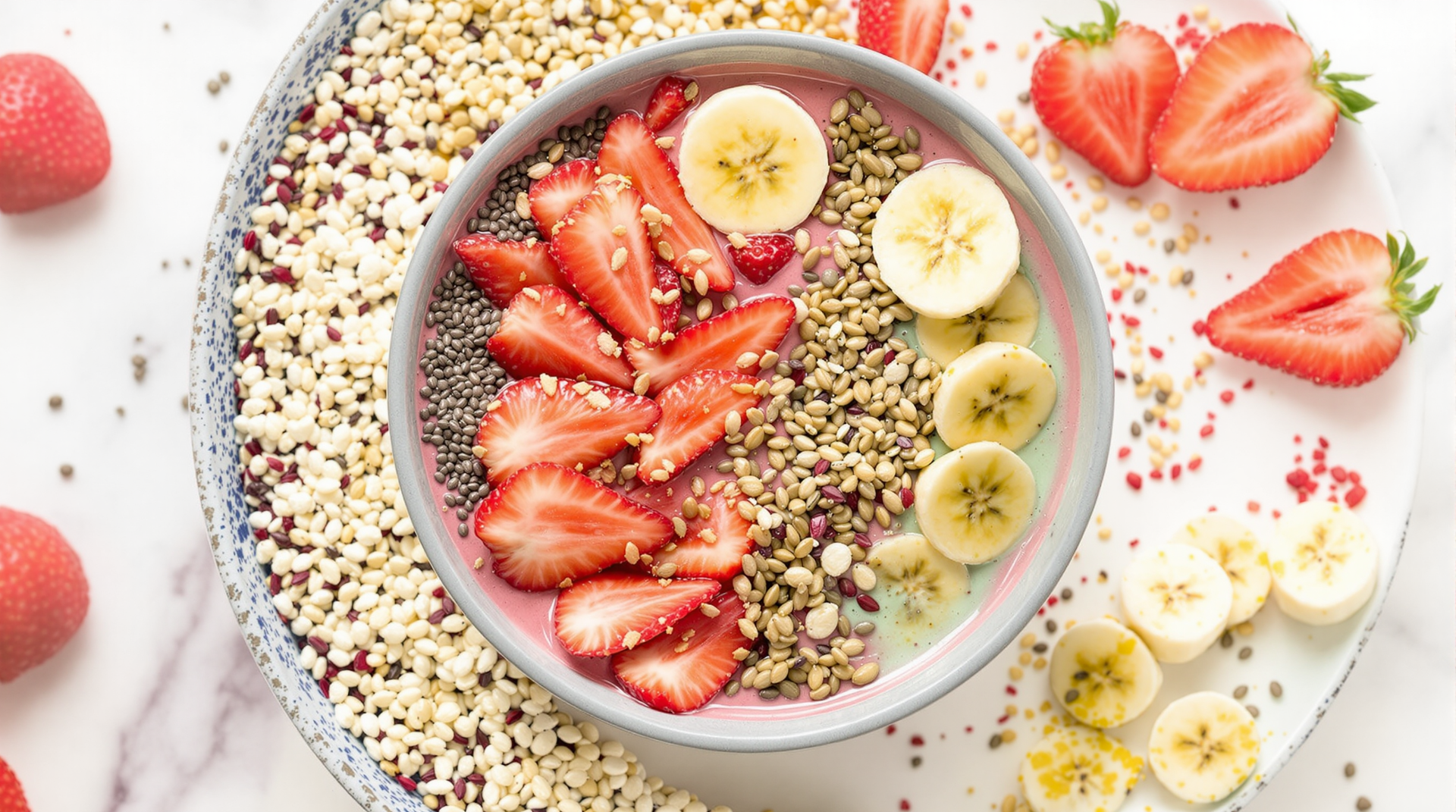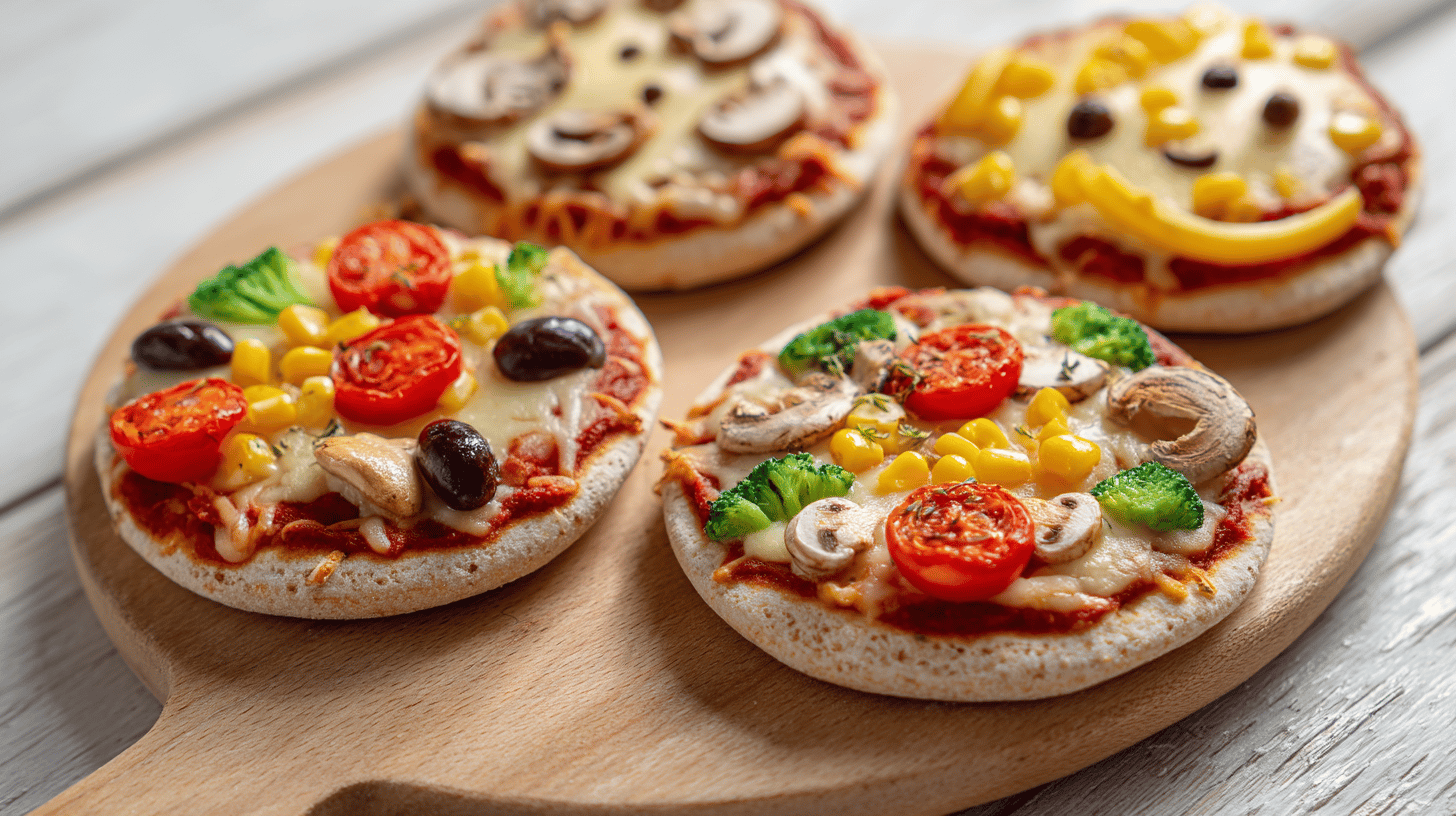Recipes for children: Colourful and healthy vegan dishes
Discover simple and tasty vegan recipes for kids full of color and healthy ingredients. Get inspired and cook with joy!
Cooking for children can be fun, creative and healthy at the same time. In this article, we present simple vegan recipes that are full of color, flavor and nutrients. You will learn how to prepare meals that will not only delight children but also support their healthy development. Get ready for inspiration that will transform your family cooking!
Why it is important to cook healthy and colorful for children

The importance of a varied diet for child development
A varied diet is key to ensuring that children get all the nutrients they need for their growth and development.
Each colour on the plate represents a different type of vitamins, minerals and antioxidants that support different body functions.
For example, red foods such as tomatoes or red peppers contain lycopene, which benefits heart health.
Purple foods, such as blueberries or eggplant, are rich in anthocyanins, which promote brain health.
In addition, a varied diet helps children develop healthy eating habits from an early age. When children become accustomed to different tastes, textures and colors, they are more likely to be open to healthy and varied foods as adults.
A varied diet also helps prevent deficiencies in nutrients such as iron, calcium or vitamin C, which are key for bone growth, blood formation and boosting immunity.

How colours and presentation affect appetite
Children are naturally drawn to visually appealing foods. Colours and creative presentations can make an ordinary meal a fun experience.
For example, a vegetable soup may be uninteresting to a child, but if you decorate it with a 'sun' made of corn and carrots or create a 'face' made of cherry tomatoes and broccoli, the child will eat it with more enthusiasm.
Creative food presentation also encourages curiosity and a desire to discover new foods. Children who encounter food in a playful way are more willing to taste even ingredients they would otherwise reject.
For example, green foods such as spinach or broccoli may be less appealing to children, but if you incorporate them into a colourful smoothie or serve them as 'trees' on a plate, they can become a popular part of their diet.In addition, colour and presentation can help children understand the importance of healthy eating.
By explaining that each colour on the plate has a meaning - for example, that orange carrots help the eyes and green spinach strengthens muscles - they can develop a positive relationship with food and healthy living.
Children are naturally drawn to visually appealing foods. Colours and creative presentations can make an ordinary meal a fun experience.

Psychological influence of colours on children
Colours also have a psychological effect on mood and appetite. Bright and warm colours such as yellow, orange or red can stimulate appetite and create a feeling of joy and energy.
Conversely, dark or bland colours can be less attractive and reduce interest in food. It is therefore important that children's meals are not only tasty but also visually appealing.
Colourful food can also encourage children's creativity and imagination. When you offer them a plate full of colour, they can imagine different stories or games, making food not only a necessity but also fun.
For example, green beans can be "magic beans" and red peppers can be "flames of fire".
So cooking and serving colourful food is not only a way to provide children with the nutrients they need, but also a way to motivate them to explore new tastes and create a positive relationship with food for life.
Practical tips for preparing healthy and colorful recipes for children
Tip 1: Use seasonal and fresh ingredients
Seasonal fruit and vegetables are not only tastier and more nutritious, but also more environmentally friendly. When you buy seasonal produce, you support local farmers and reduce the carbon footprint associated with importing food from far away countries.
Plus, seasonal produce often contains higher levels of nutrients because it is harvested when it is at its ripest.
Another benefit is that seasonal ingredients can inspire creative cooking. For example, in autumn you can make pumpkin soup or roasted root vegetables, while in summer you can experiment with fruit salads or homemade popsicles made with fresh strawberries and blueberries.
Children will learn to appreciate nature and its cycles, which can foster their respect for the environment.
If you have the opportunity, try visiting farmers' markets or even growing your own fruit and vegetables in your garden or balcony.
Children will be excited to see their favourite foods growing and will want to taste them.
Tip 2: Involve children in food preparation
Involving children in food preparation is a great way to motivate them to try new foods and build healthy eating habits.
When children see how food is prepared, they become more aware of what they are eating and have a greater appreciation for the outcome of their work.
You can start with simple tasks such as washing fruit and vegetables, mixing dough or decorating plates.
Older children can help with cutting soft ingredients (with supervision) or weighing ingredients. In this way, they learn basic cooking skills that will be useful throughout their lives.
Involving children in cooking also encourages their creativity. You can let them choose what colours or shapes they want to create on the plate, or ask them to come up with their own recipe.
For example, when making vegan mini pizzas, children can decide what vegetables to use and create their own 'work of art'.
Cooking together is also a great opportunity for family bonding. Spending time together, learning new things and creating memories that kids will carry into adulthood.
Tip 3: Replace unhealthy ingredients with healthier alternatives
Healthier alternatives to common ingredients can significantly improve the nutritional value of foods without affecting their taste.
For example, instead of refined sugar, you can use natural sweeteners such as maple syrup, date syrup or mashed banana. These alternatives not only add sweetness but also contain fibre, vitamins and minerals.
Instead of white flour, try using whole wheat flour, oatmeal or almond flour. These ingredients are higher in fiber and protein, which helps keep kids fuller longer and promotes healthy digestion.
If you're making pancake or muffin batter, you can replace some of the flour with blended fruit or vegetables such as pumpkin or courgette, which will add extra nutrients to the meal.
Another option is to replace butter or margarine with vegetable oils such as coconut or olive oil, which contain healthy fats.
When making desserts, you can use flaxseed mixed with water or mashed avocado instead of eggs, which adds softness to the dough while maintaining its texture.
Experimenting with these alternatives can be fun and inspiring. Children can learn that healthy food doesn't have to be boring or tasteless, and they can develop a positive relationship with nutritious foods.
Plus, by learning to recognize healthier options, they will gain skills that will help them make better choices as adults.
These handy tips will help you create healthy, colourful and tasty dishes that children will love. Combining fresh ingredients, involving children in the preparation and using healthier alternatives is the key to success in family cooking.
Colourful smoothie bowls
Smoothie bowls are a great way to offer kids a healthy and nutritious breakfast or snack that is both fun and visually appealing. The combination of banana, strawberries, spinach, plant milk and chia seeds creates a delicious blend packed with vitamins, minerals and fibre. The banana adds natural sweetness, the strawberries bring a fresh taste and the spinach subtly enriches the bowl with iron and other important nutrients.
For even more variety, you can garnish the smoothie bowl with a variety of fruits such as blueberries, kiwi or mango. Add nuts, seeds or coconut shavings for a crunchy effect. If you want to get the kids involved, let them decorate the bowl according to their imagination - they can create faces, flowers or other shapes. This way they will not only have fun, but also develop a positive relationship with healthy food.
Preparation time: 10 minutes
Servings: 2
Ingredients:
2 ripe bananas (one frozen for a thicker consistency)
150 g strawberries (fresh or frozen)
1 handful of fresh spinach
100 ml vegetable milk (almond, coconut, oat or other to taste)
1 tablespoon chia seeds
For garnish:
Fresh fruit (e.g. blueberries, kiwi, mango, banana slices)
Nuts (almonds, walnuts, cashews)
Seeds (chia, flax, sunflower)
Coconut shavings
Procedure:
- 1. Prepare a smoothie:
Place bananas, strawberries, spinach, plant milk and chia seeds in a blender. Blend until smooth and thick. If the mixture is too thick, add a little more milk.
- 2. Serve:
Pour the finished smoothie into bowls.
- 3. Garnish:
Decorate the smoothie bowls according to your taste. Use fresh fruit, nuts, seeds or coconut shavings. If you are making bowls for children, let them decorate them according to their imagination - they can make faces, flowers or other shapes.
- 4. Serve:
Serve immediately as a healthy and nutritious breakfast or snack.
Tip:
For an even sweeter taste, add dates or a drizzle of maple syrup to the smoothie.
Enjoy!
Vegan mini pizzas
Mini pizzas are the perfect choice for a quick and tasty dinner or snack that kids will love. Using whole wheat tortillas as a base not only reduces preparation time, but also increases the fibre and nutrient content. Tomato sauce adds a rich flavour to pizza and is a great source of lycopene, which promotes heart health.
Vegetables such as peppers, corn or mushrooms add colour and texture to pizza. You can also experiment with other ingredients such as olives, zucchini or cherry tomatoes. Vegan cheese adds creaminess to the pizza and kids won't even notice that it doesn't contain dairy.
Let the children decorate their mini pizzas themselves. They can choose which vegetables to use and create their own 'work of art'. This process is not only fun, but also encourages their creativity and appetite. Bake the pizzas in the oven for approximately 10 minutes until the tortillas are crispy and the cheese is melted.
Preparation time: 15 minutes
Servings: 4 mini pizzas
Ingredients:
4 whole wheat tortillas
150 g tomato sauce (e.g. passata or homemade tomato sauce)
100 g vegan cheese (grated)
1 red pepper (thinly sliced)
50 g corn (fresh or canned)
100 g mushrooms (sliced)
Optional: olives, zucchini, cherry tomatoes, fresh basil
Procedure:
- 1. Preheat the oven:
Preheat the oven to 200 °C.
- 2. Prepare the tortillas:
Place the tortillas on a baking tray lined with baking paper.
- 3. Apply tomato sauce:
Spread tomato sauce evenly on each tortilla.
- 4. Add the ingredients:
Spread the chopped peppers, corn, mushrooms and other vegetables on the sauce to taste. Sprinkle with vegan cheese.
- 5. Bake:
Place the baking sheet in the preheated oven and bake for approximately 10 minutes until the tortillas are crisp and the cheese is melted.
- 6. Serve:
Garnish the finished mini pizzas with fresh basil or other herbs and serve immediately.
Tip:
Involve the kids in the preparation - let them decorate their own mini pizzas according to their imagination. This process is fun and encourages their relationship with healthy food.
Enjoy!
Healthy fruit popsicles
Fruit popsicles are the perfect refreshment for hot summer days that kids will love. The combination of blended fruits such as mango and raspberries with coconut milk creates a creamy and sweet treat with no added sugar. Mangoes add tropical flavour and vitamin C to the popsicles, while raspberries bring fresh acidity and antioxidants.
Making popsicles is simple and kids can easily get involved. Let them choose the fruit they want to use and help them pour the mixture into the popsicle molds. If you don't have popsicle molds, you can use small cups and wooden sticks. For even more variety, you can add pieces of fruit to the mixture or sprinkle the popsicles with coconut or nuts before freezing.
Freeze the popsicles for at least 4 hours, ideally overnight. The result will be refreshing and healthy popsicles that are a great alternative to regular ice creams full of sugar and artificial ingredients.
Preparation time: 10 minutes (+ 4 hours freezing)
Portion: 6 popsicles
Ingredients:
1 ripe mango (peeled and cut into pieces)
150 g raspberries (fresh or frozen)
200 ml coconut milk (full-fat for a creamier consistency)
Optional: pieces of fruit (e.g. strawberries, kiwi), grated coconut or crushed nuts for sprinkling
Procedure:
- 1. Prepare the mixture:
Blend the mango, raspberries and coconut milk in a blender until smooth. If you like, you can divide the mixture in two and flavor each with a different fruit for a colorful layer.
- 2. Add pieces of fruit (optional):
If you want to spice up the popsicles, add small pieces of fruit to the popsicle molds.
- 3. Pour the mixture into the moulds:
Pour the prepared mixture into the popsicle molds. If you don't have moulds, use small cups and put wooden sticks in them.
- 4. Sprinkle (optional):
For extra flavor and texture, you can sprinkle the top of the popsicles with shredded coconut or crushed nuts.
- 5. Freeze:
Place the moulds in the freezer and freeze for at least 4 hours, ideally overnight.
- 6. Serve:
Remove the finished popsicles from the moulds (if this is difficult, dip the moulds in warm water for a few seconds) and serve immediately as a refreshing summer treat.
Tip:
For a sweeter taste, you can add 1-2 teaspoons of maple syrup or agave syrup to the mixture.
Enjoy!
These simple recipes are not only tasty and nutritious, but also fun to prepare. Involving children in the cooking and decorating process encourages their creativity and teaches them healthy eating habits. Try them out and enjoy your time together in the kitchen!
How veganism promotes a healthy lifestyle for children
Veganism is not only about what children eat, but also about the relationship they develop with food, nature and their bodies.
A plant-based diet offers a wide range of health benefits that can positively affect not only the physical but also the mental development of children.
In addition, veganism promotes values such as empathy, sustainability and responsibility, which are key aspects of a healthy lifestyle.

Nutrient richness for growth and development
A vegan diet, when properly formulated, provides children with all the nutrients they need for growth and development.
Foods such as pulses, whole grains, nuts, seeds and vegetables not only contain fibre, vitamins and minerals, but also healthy fats and vegetable proteins.
These nutrients support healthy bone, muscle and brain development.
For example, foods rich in omega-3 fatty acids, such as flaxseeds or walnuts, contribute to brain and nervous system health.
Leafy vegetables such as spinach or kale are great sources of calcium and iron, which are key for bone growth and red blood cell production.

Support healthy digestion and immunity
A plant-based diet is naturally rich in fibre, which supports healthy digestion and keeps the gut microbiome in balance.
A healthy microbiome is the basis for strong immunity, which is especially important for children who are often exposed to various infections.
In addition, fibre helps regulate blood sugar levels and keeps children fuller for longer, which can help prevent unhealthy overeating.
Foods rich in antioxidants, such as berries, citrus fruits or sweet potatoes, help protect the body from free radicals and promote cell regeneration.
As a result, children can better resist illness and recover faster.

Prevention of civilisation diseases
One of the greatest benefits of a vegan diet is its ability to reduce the risk of civilisation-related diseases such as obesity, type 2 diabetes and heart disease.
Children who eat a plant-based diet often have a lower intake of saturated fat and cholesterol, which contributes to maintaining a healthy weight and a healthy cardiovascular system.
In addition, a plant-based diet promotes healthy eating habits that children can carry into adulthood. When they learn to choose foods that benefit their bodies, they are more likely to avoid unhealthy habits such as overconsumption of processed foods or sweets.

Developing empathy and respect for nature
Veganism teaches children that their choices have an impact on the world around them.
When children learn that their diet can help protect animals, conserve natural resources and reduce pollution, they develop a deeper respect for nature and the environment.
This approach is not only ethical but also practical - children learn that even small changes can have a big impact.Involving children in activities such as growing their own vegetables, composting or choosing sustainable food can strengthen their awareness of ecology and sustainability.
These values will help them become responsible and conscious adults.

Mental health support
A vegan diet can also have a positive effect on children's mental health.
Foods rich in B vitamins, magnesium and omega-3 fatty acids support healthy brain function and can help reduce stress or anxiety.
In addition, knowing that their choices contribute to a better world can give children a sense of purpose and pride.
Veganism is therefore not just about food, but about a whole approach to life. It promotes health of body and mind, teaches children important values and helps them develop healthy habits that they will carry throughout their lives.









